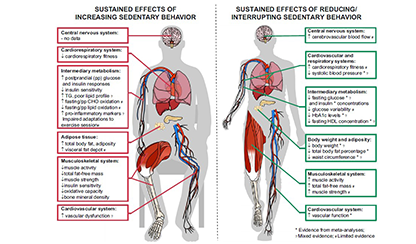
The most comprehensive review of the effects of sedentary behaviour on health and risk of death has intensified the call to reduce time spent being sedentary as well as increasing physical activity.
The extensive review, the Physiology of Sedentary Behaviour, published this month in Physiological Review, examines current understandings of sedentary behaviour (SB).
It determines that the physiological evidence now available should be used to sharpen public health and clinical practice guidelines to extend beyond just the broadly prescribed message to exercise more, and to move towards a more comprehensive message of "sit less, move more and exercise".
Head of the Baker Heart and Diabetes Physical Activity laboratory and Baker-Deakin Department of Lifestyle and Diabetes, Professor David Dunstan, is working with GPs and primary health providers to push for the inclusion of the question 'how much time do you spend sitting?' into any conversation about physical activity, as the gains from physical activity depend on how much time you also spend sitting.
"So many of us think that if we go for a short walk, a jog, or do a session at the gym after a day sitting at our desks that we're doing as much as we need to for good health, but it's not the case," Prof Dunstan said. "That's because the benefits of those physical activities depend on how much time you spend sitting.
"If, for example, you sat at your desk for hours, but then went out for a jog after work, yes, you'd certainly gain some health benefits from that run, but the nine hours seated during the day drags those health benefits down.
"By breaking up sitting time throughout the day, you break the accumulation of your sedentary time, which basically restarts the body's engine (our muscles) and lowers risk."
There is a long list of recognised health risks associated with sedentary behaviour, including high blood pressure, increased body fat, poor vascular function, and increased blood glucose and insulin.
Prof Dunstan hopes this review will help to embed his evidence-based risk identification matrix, which shows how physical activity and sedentary behaviours are inextricably linked to health risk, into healthcare practice.
"In the same way that the benefits that stem from physical activity depend on how much time is spent sitting, the health risks resulting from excessive sitting also depend on how much physical activity a person undertakes," Prof Dunstan said.
"That's why the question of how much sitting time you're doing should be asked in conjunction with how much physical activity you're undertaking, and that if you're physically inactive and sitting for long periods, you could initially start with a reduction in sitting time as a pathway to being more active.
"We have to sit less, move more and exercise to reduce our health risk."






